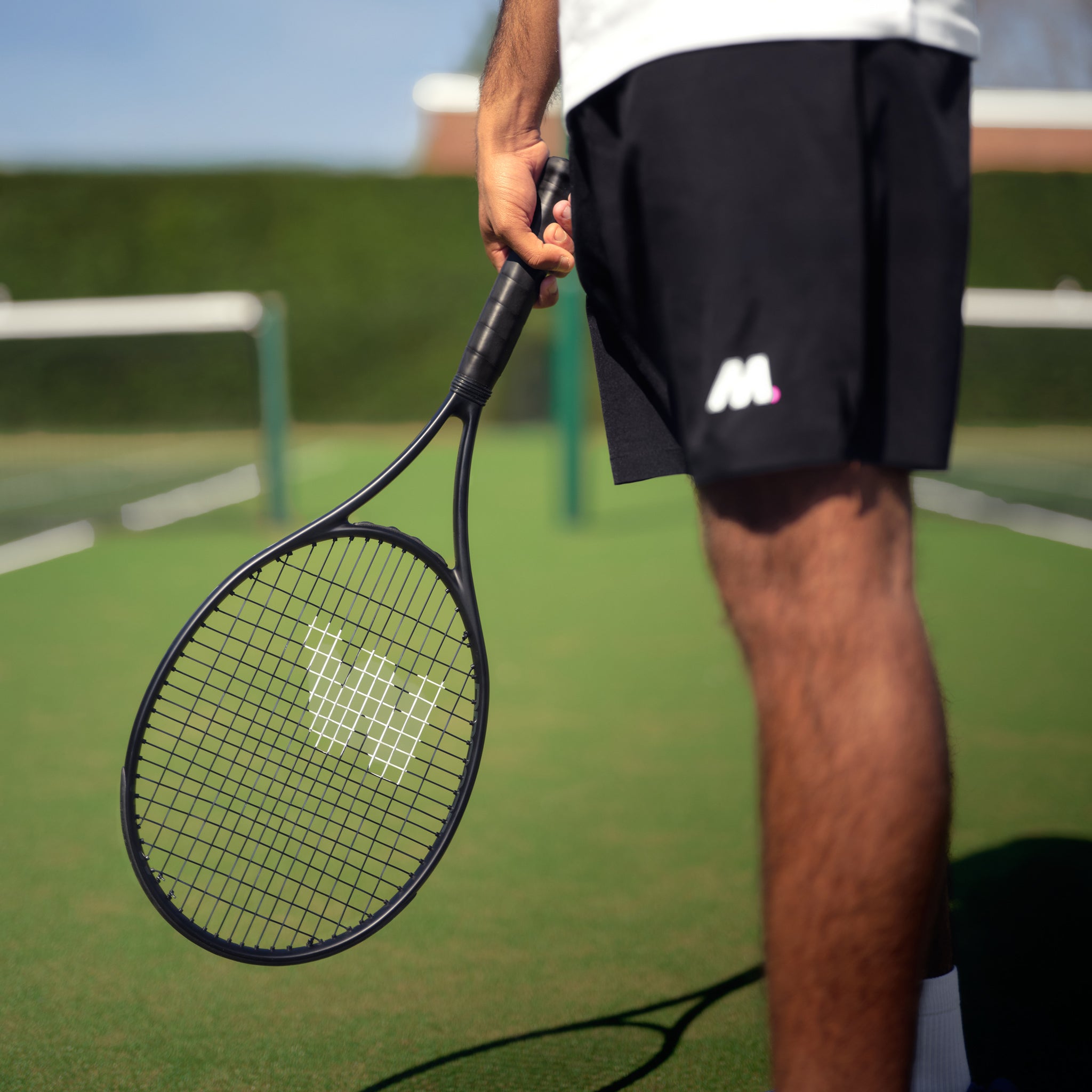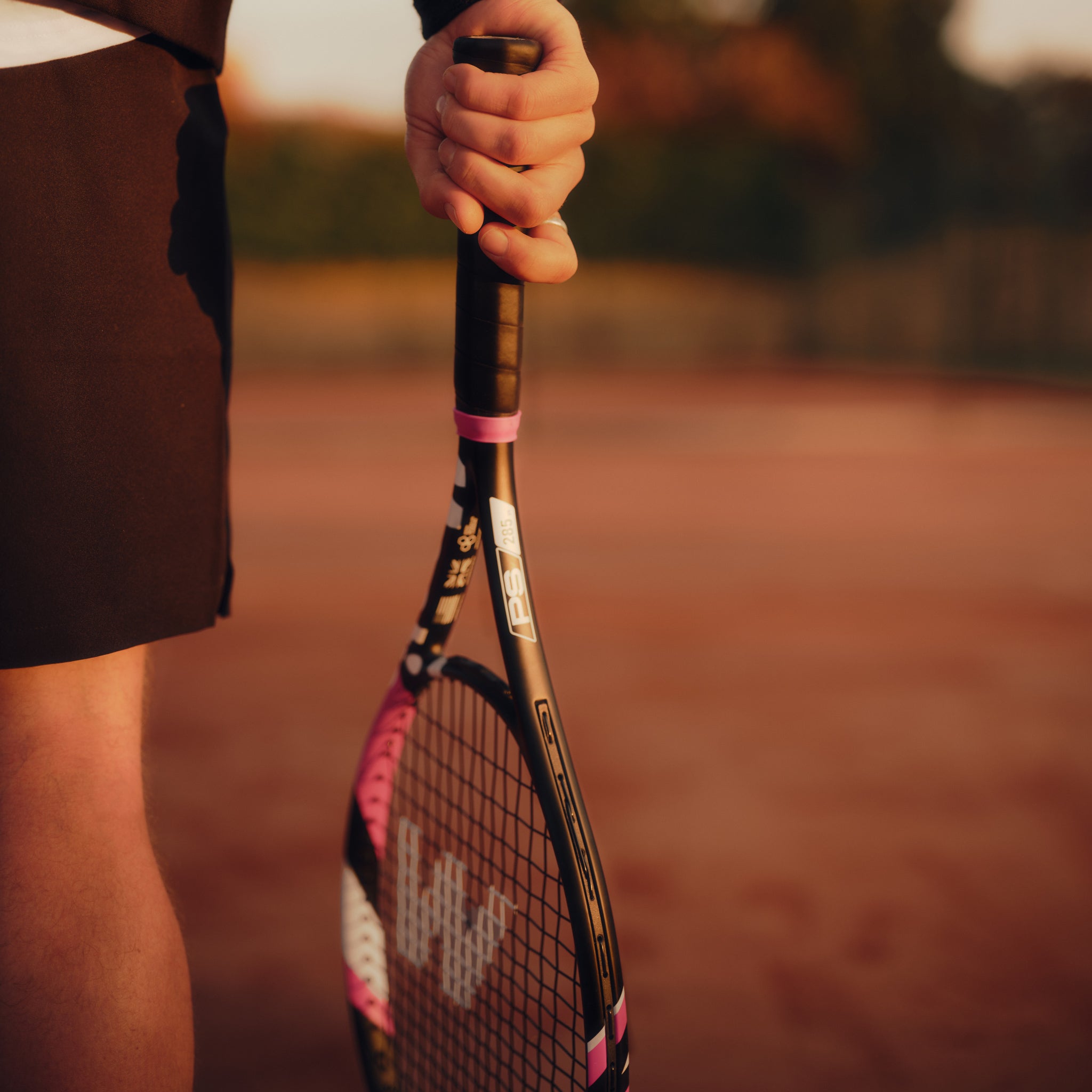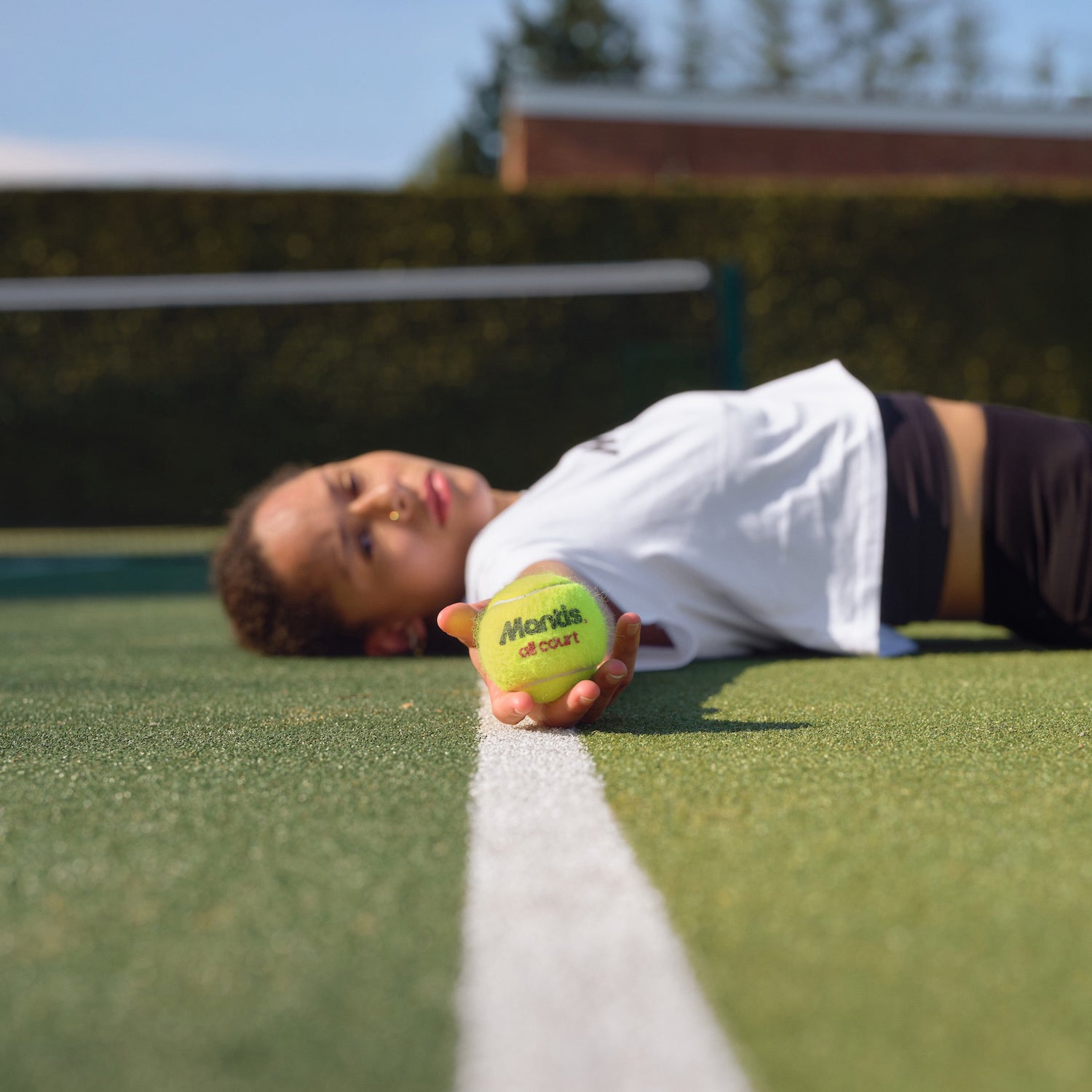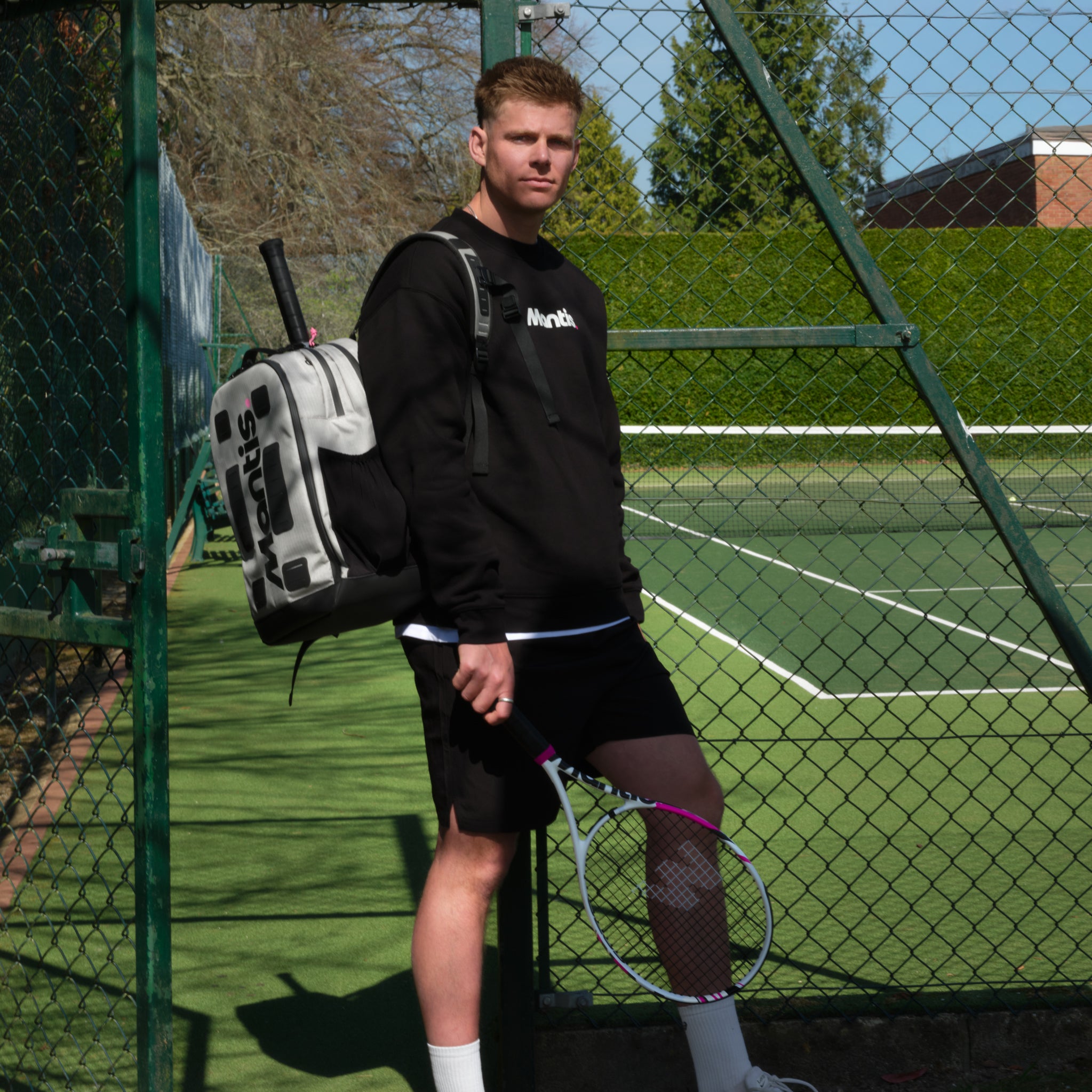
Before you can dream of hitting a perfect cross-court winner, you need to get comfortable with your new surroundings. Stepping onto a tennis court for the first time can feel a little intimidating, but it doesn't have to be when you learn tennis. We're going to start with the absolute basics: the court itself and the gear in your hand. And if you're ready to gear up, feel free to browse our full range of tennis equipment.
Your First Steps onto the Tennis Court
Welcome to tennis! It's a fantastic sport that you can enjoy for a lifetime, and we're here to help you get started on the right foot. At Mantis, we believe the best way to learn is by keeping things simple and fun.
Forget about complex techniques for now. The first real goal is just to feel at home on the court. Once you understand the space around you, everything else starts to click into place. So, let’s begin by decoding all those white lines.
Understanding the Court Layout
That grid of lines on the court isn't as complicated as it looks. Each one has a job, and knowing what they do will help you understand where to stand and where to aim.
-
The Baseline: This is your home base, the rearmost line on the court. All your groundstrokes during a rally need to land inside it. It's also where you'll stand to hit your serve.
-
The Service Boxes: See those two boxes closest to the net? Those are your targets for the serve. Your serve must land in the box diagonally opposite you.
-
The Centre Mark and Service Line: The small hash mark in the middle of the baseline helps you get in the right position for your serve. The line at the back of the service boxes is, unsurprisingly, the service line.
-
The Sidelines: You’ll notice two sidelines running down each side. The inner ones mark the boundary for a singles match. Those outer alleys, often called "tramlines," only come into play during a doubles match.
Getting to know these key areas is the first step in seeing the court as a strategic space, not just a patch of ground.
Feeling like you belong on the court is the first real victory for any new player. Learning the lines is a huge part of building that initial confidence.
Choosing Your First Essential Gear
Walking into a sports shop can be overwhelming. Walls of rackets, tubes of balls… where do you even start? The good news is, you only need a couple of key items to get going. The focus should be on practical gear that helps you learn, not on expensive kit that you don't need yet.
Finding the Right Racket
Your first racket is a big deal, but the choice is simpler than you think. As a beginner, you want a racket that's forgiving. Look for one with a larger head size—anything around 100 square inches or more is a great starting point.
This gives you a bigger "sweet spot," so even when you don't hit the ball perfectly in the centre, the racket does a lot of the work for you. A lighter frame is also a good idea. It's much easier to swing, which lets you focus on developing good form instead of wrestling with a heavy racket.
Picking the Best Balls to Learn With
You might think all tennis balls are the same, but they're not. For your first few times on court, grab some pressureless or low-compression training balls.
These are designed specifically for learners. They travel a bit slower and don't bounce as high as the ones the pros use, which gives you that crucial extra split-second to get into position and swing. It makes learning rallies so much easier and far less frustrating.
Mastering the Fundamental Tennis Grips
How you hold the racket is everything in tennis. It's the first and most critical part of the kinetic chain, dictating the power, control, and spin you can put on the ball. Get this right from the start, and you’ll find learning everything else becomes so much easier. We see it all the time at Mantis: a wobbly grip leads to a wobbly game.
Think of it this way: a poor grip forces you to make all sorts of awkward adjustments with your wrist, arm, and body just to get the ball over the net. A solid grip, on the other hand, lets your body work naturally and efficiently. For a really deep dive, we've put together a complete guide on how to grip a tennis racket.
The Continental Grip: The Jack-of-all-Trades
Often called the "hammer grip," the Continental is the one you'll use for more shots than any other. It’s incredibly versatile. To find it, just hold the racket on its edge and shake hands with the handle. For a right-hander, your index knuckle should land on bevel number two.
It's your go-to for so many situations on the court:
- Serves: This grip allows your wrist to pronate naturally, which is the secret sauce for generating real pace and spin.
- Volleys: When you're at the net, things happen fast. The Continental is perfectly neutral, so you don't need to waste precious milliseconds changing your grip for a forehand or backhand volley.
- Overheads & Slices: It's also the ideal grip for smashing overheads and carving a clean backhand slice.
While hitting groundstrokes with it can feel a bit awkward at first, learning the Continental grip is non-negotiable. It's the key to unlocking an all-court game.
The Eastern Forehand Grip: A Beginner's Best Friend
If you're just starting out, the Eastern forehand grip is where you want to begin. It's the most straightforward and intuitive grip for the forehand. A simple way to find it is to lay your racket on the ground, pick it up like you would a frying pan, and you're pretty much there.
The ideal contact point for a solid forehand is right out in front and about waist high. The Eastern grip makes achieving this clean contact so much easier because it naturally sets the racket face square to the ball. This helps you build consistency and confidence right away.
The Semi-Western Grip: Your Gateway to Topspin
Once you've got the basics down, you’ll want to start hitting with more topspin. That's where the Semi-Western grip comes in. It’s the grip of choice for a huge number of modern pros, and for good reason. From your Eastern grip, simply rotate your hand one more bevel clockwise (to bevel number four for a right-hander).
This grip naturally tilts the racket face down towards the ground. To get the ball over the net, you're forced to swing with a low-to-high motion, brushing up the back of the ball. This is exactly what creates heavy topspin, making your shots dive into the court and kick up high, pushing your opponent onto their back foot.
A Beginner's Guide to Essential Tennis Grips
Learning the differences between these core grips is the first step to mastering them. This table breaks down what you need to know about each one.
| Grip Type | Primary Use | Key Advantage for Beginners | How to Find It |
|---|---|---|---|
| Continental | Serves, volleys, overheads, slices | The most versatile grip; essential for an all-court game. | "Shake hands" with the racket; index knuckle on bevel 2. |
| Eastern | Flat and powerful forehands | Very intuitive; naturally squares the racket face for consistency. | "Pick it up like a frying pan"; index knuckle on bevel 3. |
| Semi-Western | Topspin-heavy forehands | Generates significant topspin to control points. | Rotate one bevel from Eastern; index knuckle on bevel 4. |
Ultimately, choosing the right grip depends on the shot you’re hitting. Getting comfortable with these three will give you the foundation you need for almost any situation you'll face on the court.
The goal isn't to pick one grip and use it for everything. Great players can shift between grips without even thinking about it. Building that muscle memory from day one is a true game-changer.
Here's a simple drill you can do at home: while you're sitting on the sofa, just hold your racket and practise switching between the Continental, Eastern, and Semi-Western grips. Do it without looking. Get a feel for the bevels under your knuckles. The more you do this, the more automatic it becomes, freeing you up to focus on the most important thing: the ball.
Developing Your Core Tennis Strokes
Okay, so you've got a handle on the grip. Now for the fun part: actually hitting the ball. The real magic of tennis happens in the rallies, and your ticket into that world is mastering the four fundamental strokes—the forehand, backhand, volley, and serve. These are the absolute cornerstones of the game.
Here at Mantis, we've guided countless players from their first swing to their first match, and we always start by breaking down each movement into simple, repeatable actions. It's not just about swinging hard; it's about building a solid foundation. That means understanding how to prepare your body, where to meet the ball, and how to finish your stroke with balance. Getting this right from the start makes all the difference.
Building A Reliable Forehand
The forehand is usually the first stroke people click with. It’s hit on your dominant side after the ball has bounced, and for most of us, it just feels like the most natural way to generate power. The secret isn't arm strength; it's using your entire body in one fluid motion.
It all starts the second you identify the ball is coming to your forehand. Your first move should be to turn your shoulders and hips, getting sideways to the net as you take your racket back. As the ball comes into your hitting zone, step forward with your opposite foot and let your hips and shoulders rotate back towards your target as you swing.
The sweet spot for contact is out in front of your body, right around waist height. Don't just stop the racket once you've hit the ball! A proper follow-through, where your arm continues across your body and finishes over your opposite shoulder, is vital for control and—just as importantly—preventing injury.
Mastering The Backhand Groundstroke
On the flip side, you have the backhand, hit on your non-dominant side. If you're just starting, we almost always recommend the two-handed backhand. It gives you a level of stability and power that's much harder to find with one hand early on.
The prep is just as critical here as it is for the forehand. As the ball approaches, get that body turned sideways again. A great little tip is to try and get your chin to touch your front shoulder as you prepare—that’s how you know you've got a full and proper shoulder turn.
From this coiled position, you'll step into the shot and swing from low to high, meeting the ball out in front. Think of players like Novak Djokovic; his two-handed backhand is one of the most feared shots in the game, proving just how effective it can be.
A fantastic mental cue for the two-hander is to think "push and pull". Your dominant hand pushes the racket through the contact point, while your non-dominant hand pulls it around, giving you that perfect blend of power and control.
Controlling The Net With Volleys
Volleys are a different beast altogether. These are the shots you hit before the ball bounces, usually when you're up close to the net. There’s no time for a big, looping swing here; volleys are all about quick reactions and a short, punching motion.
For both forehand and backhand volleys, the Continental grip is your best friend. Its versatility means you don't have to fiddle with changing grips mid-point, which is a lifesaver when the ball is flying at you. The technique itself is quite simple:
- Keep it short: The backswing is minimal. Think compact and efficient.
- Step into it: As you make contact, step forward with your opposite foot. This directs your body weight into the shot.
- A firm wrist is key: Your wrist should stay firm and locked. The power comes from the pace of the incoming ball and your body, not from a flick.
- Punch, don't swing: Imagine you're blocking or punching the ball back over the net.
The single biggest mistake we see beginners make is letting the ball get too close to them. You have to meet it out in front to stay in control.
The Serve: The Most Important Shot
The serve is the one shot in tennis where you have total control. It starts every single point, and developing a consistent serve is a game-changer, even when you're just starting out. It can feel a bit awkward at first, but we can break it down. We recommend starting with the Continental grip, as it makes the natural wrist snap (pronation) much easier down the line.
The absolute make-or-break element for any beginner's serve is the ball toss. Your toss determines everything. You need to be able to toss the ball to the exact same spot every time—slightly in front of you and into the court, peaking just a little higher than you can reach with your racket. Seriously, a dodgy toss is the root cause of 90% of serving problems.
Once you can get the toss right, you can focus on the swing itself.
- Begin in a relaxed, sideways stance.
- As you toss, bring the racket up into the "trophy pose"—your non-hitting arm points towards the ball, and your racket is held high.
- Let the racket head drop behind your back before accelerating up and forward to strike the ball at the highest point of your reach.
- Let your arm naturally follow through across your body. This pronation is where the real pace comes from later on.
Don't even think about hitting it hard at first. Your only goal should be to create a smooth, repeatable motion that lands the ball in the service box consistently. The power will come with time and practice. With these four strokes in your toolkit, you'll be ready to play a proper game and experience the real thrill of tennis.
Getting Your Feet Right: Footwork and Court Positioning
You can have the most beautiful swing in the world, but it’s completely useless if you can’t get to the ball on time. Tennis is a game of constant, explosive movement, and your footwork is the engine that makes everything else possible. Here at Mantis, we believe that learning to move correctly is every bit as important as learning to hit a forehand.
It’s not just about raw speed, either. Great movement is all about efficiency—taking the right number of steps, staying balanced through every shot, and learning to read where your opponent is going to hit next. Polish your footwork, and you’ll give yourself the best possible chance to hit every single ball from a stable, powerful position.
This dynamic nature is a huge part of why tennis is so popular. In the UK, the sport is thriving, with the Lawn Tennis Association (LTA) reporting that an incredible 5.6 million adults played at least once last year. That passion has helped make Great Britain the number one country in the world for adult tennis participation per capita.
For a closer look at the specific exercises that build a solid foundation, check out our guide on essential tennis footwork drills.
The Secret Weapon: The Split Step
If there’s one piece of footwork you absolutely must master, it’s the split step. Watch the pros—you’ll see them do it before every single shot. It’s that small, controlled hop you take just as your opponent is making contact with the ball. This simple move is your launchpad, priming your body to explode in any direction—left, right, forwards, or back.
The timing is what makes it work. You want to land a split second after your opponent hits the ball. That tiny moment of suspension gives your brain time to process the ball's trajectory, allowing you to push off powerfully towards it. Without a split step, you’re always playing catch-up, reacting a fraction of a second too late.
Choosing Your Stance on the Fly
Your stance—how your feet are positioned when you strike the ball—is the bedrock of your balance and power. You’ll find yourself using three main stances, and a big part of getting better is learning which one to use in the heat of a rally.
-
The Closed Stance: This is the classic textbook stance. You step across your body with your front foot, turning yourself completely sideways to the net. It’s perfect for generating maximum power because it lets you fully rotate your hips and shoulders, but it’s best used on neutral balls when you have a bit of time.
-
The Open Stance: This is the modern go-to for playing under pressure. Your body stays more open, or facing the net, as you hit. It’s an absolute lifesaver when you're stretched wide or need to recover your court position quickly. You generate power from your upper body rotation, making it essential for defence.
-
The Semi-Open Stance: Just as it sounds, this stance is a brilliant mix of the other two. It gives you a great combination of balance, rotational power, and recovery options, making it probably the most versatile stance you'll use for groundstrokes.
A fantastic way to build the explosive quickness needed for all these movements is by incorporating jump rope exercises into your fitness routine. It’s a simple but incredibly effective way to develop the fast-twitch muscle fibres that tennis demands.
Where to Stand: The Art of Court Positioning
Getting to the ball is one thing; being in the right place to begin with is another. Smart court positioning is what separates good players from great ones. If you’re constantly scrambling, you’re probably out of position.
The golden rule is simple: after every shot you hit, your first priority is to get back to the middle of your opponent's most likely returns.
This "recovery spot" isn't always the centre hash mark. Think about it: if you hit a deep cross-court shot to your opponent's backhand corner, their easiest replies are back cross-court or down the line. Your ideal recovery spot, then, is a few steps to the forehand side of the centre mark, right in the middle of those two options.
This rhythm of hit-and-recover is the fundamental dance of a tennis point. Master it, and you’ll find yourself in control, forcing your opponent to aim for smaller and smaller targets while you wait for the right moment to attack.
Getting on Court: Practical Drills and Next Steps
Right, you’ve got the basics down. But knowing what to do and actually doing it are two different things in tennis. This is where the real fun begins – getting on court and turning those ideas into muscle memory.
We're going to cover a few simple, effective drills that will help lock in your groundstrokes, volleys, and serves. Think of it as building your game brick by brick through repetition. To get started, you'll want some durable balls designed for this kind of practice, like our tennis coaching balls. The goal here isn't to hit flashy winners; it's to groove your strokes until they feel completely natural.
Drills You Can Do On Your Own
You don't always need a partner to have a productive hit. A practice wall or even an empty court can be your best friend for honing your technique without any pressure.
-
Wall Rallies: This is a classic for a reason. Find a good practice wall and start close, just tapping the ball back and forth. Really focus on that clean contact point. As you feel more comfortable, slowly step back and start taking your full forehand and backhand swings. It’s brilliant for finding your rhythm.
-
Serve Targeting: Grab an empty ball can or a cone and place it in the corners of the service boxes. Forget about power for now. Your only job is to serve with the intention of knocking over the target. This simple exercise immediately gets you thinking about placement and purpose.
-
Shadow Swings: Don't underestimate the power of practising without a ball. Go through the motions of your forehand, backhand, and serve in slow motion. Pay attention to your form, your balance, and that all-important follow-through. It’s a fantastic way to iron out bad habits.
Drills to Try With a Partner
Having someone on the other side of the net opens up a whole new world of practice. These drills are cooperative, not competitive. The aim is to build consistency together.
Your shared goal should be simple: keep the ball in play as long as possible. This not only builds stamina but teaches you the value of hitting reliable, high-percentage shots.
-
Cross-Court Rally: One of you takes the deuce court corner, the other the ad court corner. Your mission is to rally diagonally, aiming to hit 10 consecutive shots into the cross-court half. Once you manage it, switch to the other diagonal. Pros do this drill constantly because it’s a powerhouse for building consistency.
-
Volley vs. Groundstroke: One player takes the net, the other stays on the baseline. The baseline player feeds comfortable balls to the net player, who focuses on punching the volleys back with control. After a few minutes, swap places. This is a great way to sharpen your reflexes at the net and your control from the back of the court.
What Comes Next in Your Tennis Journey
Okay, you’re grooving your strokes. Now what? The next step is getting comfortable enough to play a proper match. To do that, you'll need to get your head around the unique language of tennis scoring and figure out where to find a game.
The scoring can feel a bit odd at first – with its love, 15, 30, and 40. Just remember, a game is won by scoring four points (and being two clear). You need six games to win a set, and most matches are the best of three sets. It sounds complicated, but it clicks into place quickly once you're on the court.
Honestly, the best way to learn scoring is to just play. Find a patient friend and start a practice match. The rules will make far more sense in action than they ever will in a rulebook.
Finally, finding people to play with is the key to staying motivated. Most local parks have courts you can book, and nearly all tennis clubs are delighted to welcome new members. They often run social mix-ins where you can just turn up and be paired with players of a similar level.
It’s the perfect bridge from practice to friendly competition. With around 16,800 courts across the UK, there’s bound to be one nearby. It’s a thriving scene, with data showing that between 2017 and 2023, about 8.4% of children in England played tennis. Now, go find a court
Your Questions About Learning Tennis, Answered
Starting anything new, especially a sport like tennis, naturally comes with a few questions. We get asked a lot of the same things by people just picking up a racket, so we've put together some answers to help you feel more confident and prepared. Getting these common queries sorted out from the beginning will make your journey into the sport much smoother and a lot more fun.
One of the first things people wonder is, "Do I need to be really fit to start?" The short answer is absolutely not. In fact, it's the other way around – tennis is a brilliant way to build your fitness. You can begin at a comfortable pace, just knocking a ball back and forth with a friend, and then ramp up the intensity as your skills and stamina grow.
How Much Does It Cost To Learn Tennis?
The cost of getting into tennis is another common concern, but you'll be pleased to know it's one of the more accessible sports. While you can spend a fortune on top-tier gear, you really don't need to.
- Rackets: A solid beginner's racket is forgiving, easy to swing, and won't break the bank. You don't need the same model a pro uses on television.
- Courts: Check out your local parks and councils. Many offer public courts that are either completely free or can be booked for a very small hourly fee.
- Balls & Shoes: A can of balls and a good pair of supportive trainers are the other key bits of kit. For shoes, look for non-marking soles made for court sports; they give you the right kind of grip and help prevent injuries.
Honestly, you can get everything you need for your first few months on the court for less than the price of a decent dinner out. We also recommending seeking some expert advice from a tennis coach if you need it
Understanding Basic Tennis Etiquette
Finally, getting a handle on the unwritten rules will help you feel at home on any court, whether it’s at a private club or your local park. Tennis is built on a strong tradition of sportsmanship, and a few simple courtesies show respect for the game and your fellow players.
One of the biggest unspoken rules is to never walk behind someone's court while they are in the middle of a point. It’s a simple act of courtesy, but it makes a huge difference to a player's concentration. Just wait for the rally to finish.
A few other things to keep in mind: always call the score out clearly before each serve, and if your ball rolls onto another court, wait for their point to end before you go to retrieve it. Nailing these little details will help you blend into the tennis community from day one.
Mantis believes that real progress in tennis comes from having equipment you can trust. Our rackets, balls, and accessories are engineered with a single purpose in mind: to help you play your best game. Explore our collection at https://mantissport.com.








